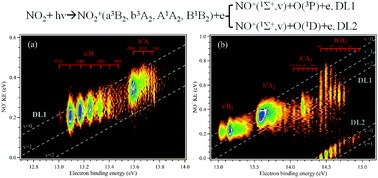High resolution vibronic state-specific dissociation of NO2+ in the 10.0–15.5 eV energy range by synchrotron double imaging photoelectron photoion coincidence†
Abstract
Vacuum ultraviolet (VUV) photoionization and dissociative photoionization of NO2 in the 10.0–15.5 eV energy range have been investigated in detail by using high-resolution double imaging photoelectron photoion coincidence (i2PEPICO) at synchrotron SOLEIL. Five low-lying electronic states of the NO2+ cation, X1Σg+, a3B2, b3A2, A1A2 and B1B2, are prepared with well-resolved vibronic structures and their state-specific dissociation mechanisms are unraveled and discussed. The present experimental results clarify that except the X1Σg+ ground electronic state and the first three vibrational levels of the a3B2 electronic state, the other cationic states of NO2+ within the present energy range are totally dissociative towards the NO+(X1Σ+) + O(3P) and/or NO+(X1Σ+) + O(1D) dissociation limits. An energy barrier exists along the direct dissociation route of the a3B2 state, and the b3A2 electronic state is a quasi-bound state with a very shallow well, both of which adiabatically correlate to the NO+(X1Σ+) + O(3P) dissociation limit. The a3B2 state mainly with bending vibration excitations undergoes a non-adiabatic transition to the 23A′′(3B1) repulsive state along its bending potential energy curve and then predissociates into the NO+(X1Σ+) + O(3P) products. Our experimental results firstly demonstrate that the NO+(X1Σ+, v) fragment ions produced from individual vibronic levels of the dissociative NO2+(a3B2, b3A2) states are produced at the v = 0 ground vibrational level with a high rotational population due to the excitation of the vibrational bending mode of NO2+ and the associated imparted torque upon dissociation. The slower predissociations of the A1A2 and B1B2 electronic states via their spin–orbit couplings with the repulsive 23A′′(3B1) state produce the NO+(X1Σ+) and O(3P) fragments with a long vibrational progression. In addition, the B1B2 state can also undergo a radiationless transition such as internal conversion into the hot X1Σg+ state and then dissociate into the second dissociation channel correlated to the NO+(X1Σ+) and O(1D) products.

- This article is part of the themed collection: 2020 PCCP HOT Articles


 Please wait while we load your content...
Please wait while we load your content...